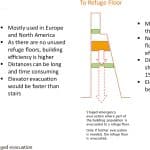Voluntary Egress Elevators: Enhancements to the 2004 CTBUH Guideline
Dec 1, 2019
Updates are evidence of efforts by several vertical-transportation organizations to solve barriers to public safety in new and even existing buildings.
by Johannes de Jong
In 2004, the CTBUH published its Emergency Evacuation: Elevator Systems Guideline.[1] After the tragic events of 9/11, it was clear that it was time to enhance egress methodologies for high-rise buildings. This concise yet comprehensive booklet summarized the benefits to be attained from evacuation elevator systems, outlined three levels of protection and the related key design criteria. The guide also explored the considerations to be taken when designing egress elevators and mapped out the protocols for total, staged and fractional evacuation using elevators. The guide was well received, as the marketplace was looking for new ideas to enhance high-rise safety. This need has not changed.
In the U.S., this guideline was implemented by several regulatory organizations. The International Code Council (ICC) allowed voluntary use of automated self-evacuation through Occupant Evacuation Operation (OEO) in the International Building Code (IBC),[2] and the American Society of Mechanical Engineers updated the U.S. elevator code, ASME A17.1,[3] to include voluntary OEO. While it is a great achievement, the take-up of emergency egress elevators as a design concept has been very limited and not as widespread as one could have hoped.
This article will review the ongoing barriers to implementing voluntary egress elevators (VEEs) as part of the design solution for tall buildings and set out solutions for breaking down these barriers.
Key challenges and opportunities to improve VEE economics, using incentives in combination with the latest elevator control methodologies and smoke protection solutions and smoke-spread knowledge are explored. Global experts such as Liftinstituut, an authorized body for both the European and the North American market; Elevating Studio Pte. Ltd.; and Olsson Fire & Risk Ltd. joined forces in a study with the European elevator industry to explore how to solve these barriers for new and even existing buildings.
Introduction
Emergency evacuations in buildings are often linked to fire first, since fires can have catastrophic effects on buildings and are prominent in the cases shown to us on the news. For example, the Grenfell Tower fire in London on June 14, 2017, caused the death of 71 people and injured more than 70 others. Often, catastrophic events act as catalysts for improvements in building safety systems.
The findings of the Emergency Evacuation: Elevator Systems Guideline were implemented in North America as OEO, the first voluntary evacuation code implemented globally. The fact that OEO has only been used in a limited number of cases and never really took off made us study what is restricting the use of voluntary evacuation systems and what could be done to make them more commonplace. This article presents the result of our findings, which we hope will be used as input for a revision of the Emergency Evacuation: Elevator Systems Guideline.
Emergency Evacuation Needs
Emergency evacuation is not only needed in fire cases; it is also applied in the following cases:
- Power blackouts: large power blackouts like the NYC blackout in 1977 required the evacuation of buildings before the buildings’ emergency power systems would become ineffective.
- Terrorist acts such as bomb threats, biological warfare, gas attacks and radiation attacks are all situations in which buildings need to be emptied to minimize or prevent casualties.
- Natural disasters such as typhoons, hurricanes, earthquakes, tsunamis and floods can render buildings unsafe and, thus, require emergency evacuation of these structures.
- Manmade disasters such as nuclear and chemical accidents may require whole regions to be evacuated. Buildings will need to be evacuated as part of the regional evacuation. The use of elevators to evacuate the building is
The use of elevators to evacuate the building is common practice in practically all these situations. In fires, however, we are clearly instructed not to use the elevators or lifts. We have all seen signs as shown in Figure 1, but what about those occupants who are not capable or fit enough to use the stairs?
Let me explain a personal story, which is a great example: I found myself in exactly such a situation in a Wall Street hotel fire in NYC some years ago. With the first alarm, we were asked to use the fire stairs. I just managed to make it down, when we were told that the situation was under control. We were then allowed to go back to our rooms.
Fewer than 15 min later, we were disrupted by yet another fire alarm. Still fatigued from the first alarm, I tried the elevators, and, to my surprise, the elevators were still available, and I made the ride down the “illegal” way.
Because I suffer from badly worn knees, I would certainly not have been able to make it down again taking the stairs. This time, the doors of the main lobby were all open with firefighters all over the place and a wet floor with several fire hoses, while smoke appeared from the ground-floor kitchen. This time, it was a real fire! And, as such, there was a real evacuation need.
Emergency Evacuation and Elevator Protection Types
The CTBUH guideline described three different types of evacuation and three protection levels for elevators. The three evacuation types can be found in Figure 2, while the three elevator protection levels are shown in Figure 3. What is not, however, described by the CTBUH guideline is how to link the elevator protection level to the different evacuation types. It should, however, be clear to anyone that the greater the risk for the user, the higher the protection level of the elevator should be to prevent user safety risks during evacuation.
In Europe, several codes describe how elevators should work in case of fire:
- EN 81-72 Safety Rules for the Construction and Installation of Lifts — Particular Applications for Passenger and Goods Passenger Lifts: “Firefighter lifts”:[4] This code describes the use of protected elevators solely to be used by firefighters in fires.
- EN 81-73 Safety Rules for the Construction and Installation of Lifts — Particular Applications for Passenger and Goods Passenger Lifts: “Behavior of lifts in the event of fire”:[5] This code describes the behavior of elevators other than the firefighter elevators described in EN 81-72: for example, recall of all goods and passenger elevators is described in detail.
- CEN/TS 81-76 “Evacuation lifts”: [6] This code is still a draft and will soon be published. It describes how elevators in compliance with EN 81-72 are used for fractional evacuation of those who cannot save themselves (those not capable of using the stairs).
Though these codes exist, firefighters and, especially, fire departments in many European countries are not happy with the rules in them. EN 81-72 allows cars as small as 680 kg. This is problematic for firemen in full gear, which they will need to remove if they need to rescue themselves from the car.
Fire chiefs also complain that EN 81-76 interferes with their main task, which is to save the building. Saving the building is the most efficient way for firefighters to save lives. Saving lives of those waiting in firefighter lobbies will block and possibly prevent access to the same elevator they also need to save the building. It could also be used to save even more people on higher floors.
Fire chiefs in several countries explained they would like to be able to use the passenger elevators for certain rescue operations in which larger crowds are involved, provided they felt the elevators were safe enough to be used. For example, Dutch firemen used the passenger elevators in a large catastrophic fire in Nijmegen to save many lives. Even in West London’s Grenfell Tower fire, many of the residents saved themselves by using the elevators; also, here, the homing function of some of the elevators “fortunately” failed.
In the U.S., the ICC allowed voluntary use of automated self-evacuation through OEO in the IBC. ASME updated the U.S. elevator code, ASME A17.1,[3] to include voluntary OEO. Like EN 81-73, this standard already describes the recall of elevators. OEO was introduced with the most common serious threat, fire, in mind, as smoke and heat are known killers. OEO evacuation begins on the two floors above and two floors below the fire floor.
OEO requires maximum protection for elevators (the “protected elevator” as described in the CTBUH guideline).
Protected elevators, unfortunately, significantly increase the costs of elevators due to the many technical provisions required to keep the elevators safe. In addition, OEO allows the reduction of one of the fire stairs above a certain height in cases where two stairs are needed. However, in cases where the OEO elevators do not function, there is a shortage of a fire stair. In our opinion, it is not advisable to reduce the number of fire stairs (which is always the safest and most reliable way to evacuate) through the provision of OEO elevators.
The Right Protection Type for the Right Situation
General Considerations
In fires, most casualties are typically caused by smoke. Particularly, smoke that spreads to areas where people will need to wait for elevators will limit the availability and usability of emergency egress elevator systems. There are no other smoke barriers between the fire area and the lobby, other than the normal doors used in the building, in a standard elevator system. The more doors there are, the more limited the smoke spread. In residential buildings, fires typically occur in the residential units, and one can normally find multiple doors to the elevator lobby.
Even in an open space, smoke will take several minutes to spread to the lobby of a standard elevator. It will take smoke typically more than 15 min to reach an elevator lobby on a non-fire floor, while it may only take 3 min for smoke to reach an elevator lobby on the fire floor. In an enhanced elevator system, the lobby is protected by extra smoke-stop doors. This extends the time it takes for smoke to reach the elevator lobby. On a fire floor, this can practically double the time it will take for smoke to reach the lobby to 5 min. On a non-fire floor, smoke can be kept out of the lobby for up to 30 min. Protected elevator systems with pressurized lobbies can provide a longer time, which should be enough for a total building evacuation using lifts.
Note that fire detection systems in larger buildings can become rather complex. They may be seldomly used and plagued by improper maintenance over the years. As a result, most fire alarms are false alarms. To prevent the unnecessary movement of people on stairs, it has become a common habit to first investigate whether the alarm is real or to even put out the fire locally. Either action can take up to 10 min — precious time in which smoke can spread far into open spaces.
To keep the protection level and, thus, the costs of the emergency egress elevator system as low as possible, it is essential to initiate evacuation orders as early as possible and to not waste time. Naturally, this requires regular maintenance and testing of the fire detection and fire alarm systems to prevent false alarms.
Total Evacuation
The goal for total evacuation is to completely evacuate (remove) the occupants from the structure. Assembling occupants on refuge floors is not considered. Reasons for its use are:
- Catastrophic fire
- Biological or chemical attack
- Weather
- Earthquakes
- Bomb threats
- Potential catastrophic events in adjacent structures
Speed is important, though it may take up to 3 hr, depending on the building height and type. Elevators are often considered in the interest of timeliness.
Figure 5 is a simulation graph from the CTBUH guideline showing the time needed for total evacuation of a building using either elevators or stairs. The simulations assume the use of two fire stairs with an effective width of 1,100 mm throughout the building. The N values for stairs indicate the average number of persons per floor. Office buildings typically have N values of 100-200 persons per floor, where residential buildings typically have N values below 50 persons per floor.
Elevators’ capacities are based on moving a certain percentage of the population in a 5-min period. Offices are often designed with a 12-13% handling capacity in up-peak, and high-end residential buildings are based on an approximately 7.5% morning-peak capacity. Elevators designed in this way will be capable of evacuating office buildings within approximately 25 min and residential buildings within approximately 45 min. Evacuation time using only stairs will increase with height and depend on the average floor population.
A building with an average floor population of 150 persons per floor (N = 150) will be evacuated faster by elevators than by stairs if the number of floors exceeds 20. The larger the population per floor, the lower the height at which the tipping point will occur to make elevators faster than stairs. This point for residential buildings with lower population densities per floor are clearly much higher than for office buildings. With an N value of 50 persons per floor, the number of floors must exceed 70 before elevators will evacuate faster than stairs. Stairs will normally always be faster, of course, except for those not capable or fit enough to walk the stairs.
Of course, a combination of elevators and stairs will be the fastest way to empty a building. The use of elevators for total evacuation is more practical in buildings with denser populations.
Evacuation times for total evacuation are rather long (about 25 min for offices and 45 min for residential buildings). Such long evacuation times require more expensive protected elevators for fires in which smoke is an important factor.
Staged Evacuation
In staged evacuation, the evacuation is based on relocation of occupants to protected areas (areas of refuge). This can be either to dedicated refuge floors (often used in Asia and the Middle East, where local codes often regulate them) or to a building exit (often used in Europe and North America, where refuge floors are hardly ever used). Reasons to use this method are:
- “Common” non-catastrophic fire threats and/or adjacent tenant concerns
- Depending on the heating, ventilation and air-conditioning design, biological or chemical attacks may not require total evacuation.
- The less fit (disabled, obese, aged, injured, etc.) may have problems walking stairs over the height of the building, especially in very tall ones. Elevators may be needed for this part of the population.
There are typically two types of staged evacuation for high-rise buildings (Figure 9). In Europe and North America, one mostly finds the first type, “To Exit.” This system provides a higher building efficiency, as no unoccupied refuge floors are used. Distances to the exit can be long, depending on the height of the floor(s) needing evacuation. Elevator evacuation can often be faster than evacuation by stairs. Staged evacuation should be considered here.
If we evacuate the fire floor, one floor above and one floor below, we get a three-floor zone to evacuate. If all elevators are used in an N = 125 office to evacuate these floors, simulations show it will take an average of 2 min., 20 s to empty a complete floor.
Normal elevators could handle “To Exit” staged evacuation before smoke and fire spread becomes critical. It is, however, essential not to delay the evacuation order. All elevators should be dedicated to the fire floor first. The fire floor has the highest priority, after which elevators can select any floor of the staged zone. Egress time can be reduced further if part of the population uses the stairs. People on floors not served by the elevators should always evacuate by stairs.
In Asia and some parts of the Middle East, the use of refuge floors (marked green in Figure 6) are used. Building efficiency is lower, as at regular intervals the building will use unoccupied dedicated refuge floors. Distances to refuge floors are shorter, and it is typically faster to use the stairs in evacuation scenarios. Due to the ability to rest or wait here, fewer people will belong to the unfit category and will be able to walk the stairs. Evacuation using elevators is needed less here. Elevator egress may be needed when the situation on a refuge floor becomes unbearable, and a refuge floor should be evacuated toward a building exit.
Fractional Evacuation
Fractional evacuation should be used for those who cannot evacuate themselves. Presently, these persons need to wait to be rescued by firefighters. They can make up as much as 5-10% of the building population, and the higher the building, the higher this percentage will be.
In an office building with 4,500 people (72,000 m2 gross floor area [GFA]), this totals 225-450 people, or about five to 12 per floor, in an N = 125 building. If firefighters used the two firefighters’ elevators for only this purpose, it would take 20-40 min to evacuate all, depending on the elevator size and the number of wheelchair users.
We feel that the strategy set out by CEN/TS 81-76 is flawed, and we fully agree with the comments of the firefighters: that they should be focusing on saving the building and not a small portion of the building population that inhibits them from doing their job.
In other words, we must look at alternative methods of self-rescue for the disabled or unfit.
Alternative Elevator Egress Methods
In considering how self-rescue can be achieved for the disabled and unfit, we would like to prevent increased building investment costs and feel we should use the existing large elevator equipment investment in building construction (as elevators are 2-5% of the total) to achieve this goal. We have already seen failure of voluntary investment with OEO, where even the reduction of one fire stair did not compensate sufficiently for the costs.
Those fit enough to use the fire stairs should continue to do so, as is practice today. Using as many standard passenger elevators as possible for the disabled and unfit will dramatically reduce the time needed to evacuate them.
The building mentioned earlier with 4,500 persons (72,000 m2 GFA) will have some 15-16 passenger elevators, which means the disabled or unfit can be evacuated about eight times faster (within 5 min) using these elevators than by just using two firefighters’ elevators. This is quick enough for them to be able to use standard elevators for self-evacuation. However, it is important that any fire alarm is not delayed unnecessarily to prevent unnecessary spreading of smoke to the elevator lobby.
People act in a remarkably restrained fashion in fires, especially if they are guided by people controlling the situation. Floor wardens with high-visibility vests should normally have no big issues guiding the people to the right means of egress. There will, of course, always be the occasional situation where someone in the crowd feels he or she has the right to use the elevators instead of the stairs. Fortunately, the elevators will be capable of handling more than twice the maximum expected amount of people.
Conclusion
We have renamed the use of standard elevators for use to evacuate the disabled and unfit to “VEE” to differentiate from OEO. OEO is typically very expensive and optional, which combine to bar their use, making it not having been implemented to the level we would have expected. For those willing to invest in extra safety, OEO is a very good alternative, as it provides extended usage over VEE.
While VEE is also voluntary, it has no or very little extra cost, making it easy to accept. It also uses normal, standard passenger elevators and requires only some smoke detectors with 20-m visibility. VEE can also evacuate all disabled and unfit persons within 5 min, providing them a safe rescue route. The fit will use the fire stairs as is practice today.
VEE does, however, require changing the elevator recall rules to delay the process 5-10 min. This will also automatically switch off VEE, thus preventing possible smoke sensor failure from causing risks to users. VEE frees up firefighter elevators for the sole use of the firefighters so they can concentrate on their main task, saving the building.
It is our intention to update the CTBUH Emergency Evacuation: Elevator Systems Guideline to continue the work on VEEs. For those who feel they can contribute to making our buildings safer, we kindly accept your help.
- Figure 1: “IN CASE OF FIRE” sign often found near elevators
- Figure 2: The three evacuation situations: total, staged and fractional
- Figure 3: The three elevator protection levels: standard, enhanced and protected
- Figure 4: Utilization time for different protection types
- Figure 5: Total evacuation egress times by stairs or elevators
- Figure 6: The two types of staged evacuation
References
[1] CTBUH. Emergency Evacuation: Elevator Systems Guideline (2004).
[2] ICC. IBC, 2015 Edition, Section 3008.
[3] ASME A17.1/CSA B44 Safety Code for Elevators and Escalators – 2013 Edition, Section 2.27.11.
[4] CEN/CENELEC Internal Regulations. EN 81-72:2003 Safety Rules for the Construction and Installation of Lifts — Particular Applications for Passenger and Goods Passenger Lifts: “Firefighter lifts.”
[5] CEN/CENELEC Internal Regulations. EN 81-73:2005 Safety Rules for the Construction and Installation of Lifts — Particular Applications for Passenger and Goods Passenger Lifts: “Behavior of lifts in the event of fire.”
[6] CEN/CENELEC Internal Regulations. CEN/TS 81-76: “Evacuation lifts.”
Get more of Elevator World. Sign up for our free e-newsletter.














